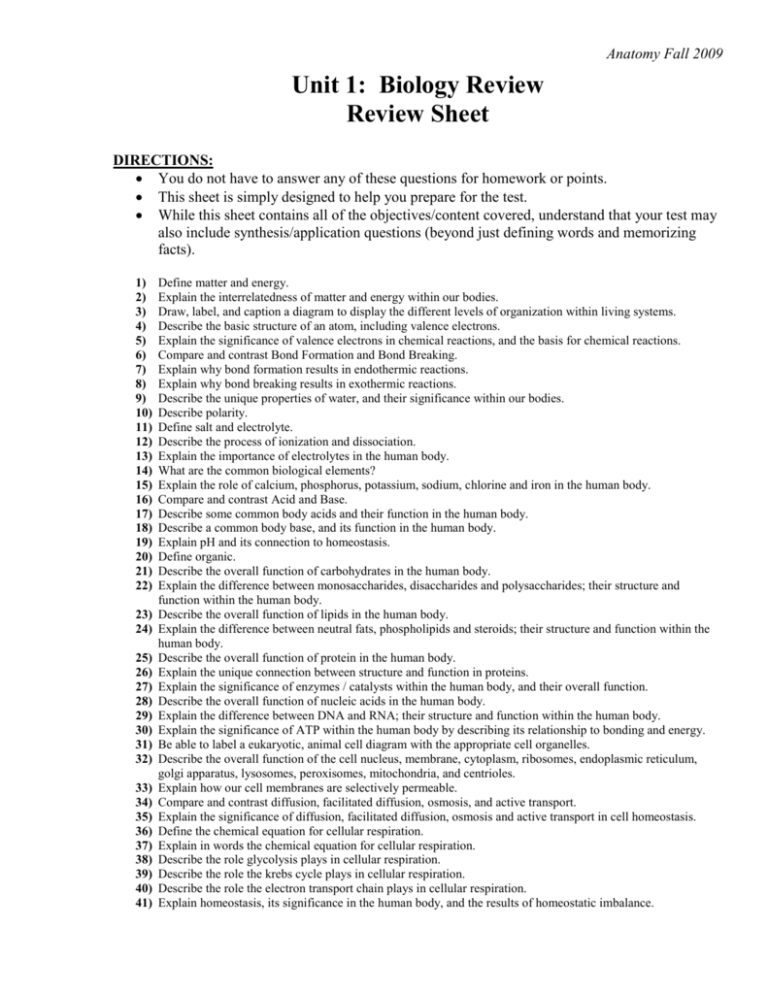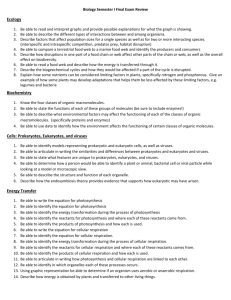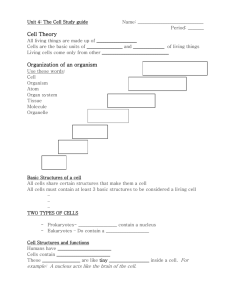Unit 1-Biology Review Test on Friday 9-18-09!
advertisement

Anatomy Fall 2009 Unit 1: Biology Review Review Sheet DIRECTIONS: You do not have to answer any of these questions for homework or points. This sheet is simply designed to help you prepare for the test. While this sheet contains all of the objectives/content covered, understand that your test may also include synthesis/application questions (beyond just defining words and memorizing facts). 1) 2) 3) 4) 5) 6) 7) 8) 9) 10) 11) 12) 13) 14) 15) 16) 17) 18) 19) 20) 21) 22) 23) 24) 25) 26) 27) 28) 29) 30) 31) 32) 33) 34) 35) 36) 37) 38) 39) 40) 41) Define matter and energy. Explain the interrelatedness of matter and energy within our bodies. Draw, label, and caption a diagram to display the different levels of organization within living systems. Describe the basic structure of an atom, including valence electrons. Explain the significance of valence electrons in chemical reactions, and the basis for chemical reactions. Compare and contrast Bond Formation and Bond Breaking. Explain why bond formation results in endothermic reactions. Explain why bond breaking results in exothermic reactions. Describe the unique properties of water, and their significance within our bodies. Describe polarity. Define salt and electrolyte. Describe the process of ionization and dissociation. Explain the importance of electrolytes in the human body. What are the common biological elements? Explain the role of calcium, phosphorus, potassium, sodium, chlorine and iron in the human body. Compare and contrast Acid and Base. Describe some common body acids and their function in the human body. Describe a common body base, and its function in the human body. Explain pH and its connection to homeostasis. Define organic. Describe the overall function of carbohydrates in the human body. Explain the difference between monosaccharides, disaccharides and polysaccharides; their structure and function within the human body. Describe the overall function of lipids in the human body. Explain the difference between neutral fats, phospholipids and steroids; their structure and function within the human body. Describe the overall function of protein in the human body. Explain the unique connection between structure and function in proteins. Explain the significance of enzymes / catalysts within the human body, and their overall function. Describe the overall function of nucleic acids in the human body. Explain the difference between DNA and RNA; their structure and function within the human body. Explain the significance of ATP within the human body by describing its relationship to bonding and energy. Be able to label a eukaryotic, animal cell diagram with the appropriate cell organelles. Describe the overall function of the cell nucleus, membrane, cytoplasm, ribosomes, endoplasmic reticulum, golgi apparatus, lysosomes, peroxisomes, mitochondria, and centrioles. Explain how our cell membranes are selectively permeable. Compare and contrast diffusion, facilitated diffusion, osmosis, and active transport. Explain the significance of diffusion, facilitated diffusion, osmosis and active transport in cell homeostasis. Define the chemical equation for cellular respiration. Explain in words the chemical equation for cellular respiration. Describe the role glycolysis plays in cellular respiration. Describe the role the krebs cycle plays in cellular respiration. Describe the role the electron transport chain plays in cellular respiration. Explain homeostasis, its significance in the human body, and the results of homeostatic imbalance.







